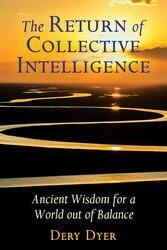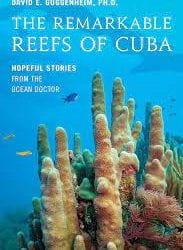A Review of The Return of Collective Intelligence
Ancient Knowledge and Modern Science: A New Paradigm for a New World

The Return of Collective Intelligence: Ancient Wisdom for a World Out of Balance by Dery Dyer, New York: Bear and Company, 297 pages.
My college Native American Culture professor, the Mescalero Apache scholar Inez Sánchez, told our class that we should regard the word “primitive” as synonymous with “complex.”
I gained a better understanding of what Sánchez meant reading The Return of Collective Intelligence, Ancient Wisdom for a World Out of Balance by the former newspaper publisher of the Tico Times in Costa Rica, Dery Dyer.
She describes how ancient cultures and contemporary indigenous people share a world view dating from a time before modern technology and the rational mind gained primacy over human affairs to impose a mechanistic view of the universe on mankind.
It was a time when humanity was dominated by civilizations ruled by a collective intelligence; a world vastly different from that of “modern man.”
The remnants of the ancient culture can be found, Dyer tells us, in indigenous cultures ranging from what remains of the Inkan civilization in South America to the Mayan civilization in Mesoamerica, to the traditional Shamanic cultures in Siberia, to the mysterious pre-Columbian spherical stones in Costa Rica, which may have been used as navigational tools for ancient mariners.
Dyer argues that in these convulsive times, we still have an opportunity to recover the world-view that offers a balance between human and the natural world through the unity of spirit, trust, openness, love and care; respect for elders and nature and fomenting a cult of the ancestors which see our ancestors as still living in the natural world and in all that is—all qualities basic to indigenous cultures and our nearly forgotten ancient past.
In ancient times and among indigenous cultures today, people saw and see themselves primarily as members of a group first, then as individuals. This allowed them to use the native intelligence of a group mind to act as one, analogous to the flocking of birds or the workings of bees.
The ancient wisdom allowed our ancestors to use energies emanating from Mother Earth to navigate following the energy bands of the earth or build technologies that allowed them to construct the enigmatic structures and artifacts we find throughout the world.
The ancients lived in a world in which everything from the smallest bacteria to rocks to the largest star vibrated with life and intelligence, a universe that increasingly looks like the one described, Dyer tells us, by modern quantum physics.
“In the indigenous world, everything is energy: alive, conscious. meaningful, and indivisibly linked; time is not linear; the universe is multidimensional; and Earth, our mother, needs loving care. It’s a world in which paradox flourishes because the limits we thought were demarcating time and space, matter and energy, you and me, don’t exist,” writes Dyer. “Our ancestors perceived no difference among what Western minds later divided into the material, the energetic, and the sacred. They understood that the same energy animates a blade of grass, a hurricane, a mosquito and us. The sacred was not remote, exclusive, or difficult to touch; it was an intimate part of every being’s life.”
Specific points on Earth and places in nature—mountains, forests, bodies of water—as well as cyclical, celestial events such as solstices, equinoxes and the appearance of certain stars, were acknowledged as openings to divine energy. Working with air, water, fire and earth in sacred places at certain times, ancient people used tools such as the circle to exchange energy with the cosmos, thereby fulfilling their responsibility to the forces of creation and receiving infusions of grace, says Dyer.
“Sacred reciprocity—the energetic give-and-take the Andeans call ayni— became the cornerstone of indigenous spiritual life,” she writes.
“[What we have today] is a dramatic breakdown of ayni: humans are no longer living in reciprocity with the Earth and her beings,” writes Dyer. “Instead of giving gratitude and care in exchange for nature’s gifts, we have disrupted the fragile balance by seeking to dominate, exploit and destroy.”
The author brings all her journalist’s skills to a narrative chalk full of attributions from anthropologists, new science thinkers, philosophers and physicists to build a persuasive case that returning to collective intelligence is not only possible but necessary to reverse the course delineated by what the author calls “collective stupidity,” the mob with a megaphone who use social media to exacerbate the artificial barriers that divide us at the cost of the universal, loving energy permeating the universe that unites us.
“If collective intelligence is a group’s connection to an infinite source of wisdom, collective stupidity is the result of consistently failing to make that connection,” writes Dyer. “Tom Atlee of the Co-Intelligence Institute believes it’s the result of competition, conformity, or ‘poorly designed systems and feedback loops that reward people for doing—or punish them for not doing—actions that are destructive over the long term or endanger the life around them.’”
Dyer notes that, “Fortunately we are waking up.” Organizations such as the Co-Intelligence Institute, the World Cafe, the Collective Wisdom Institute and the Center for Collective Intelligence at the Massachusetts Institute of Technology, are working on applications of versions of Collective Intelligence. I was disappointed that Dyer did not elaborate on the work of these groups.
As a child, Dyer’s family moved around Latin America, absorbing the cultures of many countries. She lived most of her life in the shadow of Mount Pico Blanco in Escazú, Costa Rica’s town of the witches, where stories of magical goings on include the haunting of Zárate, the witch said to inhabit the caves of the magic mountain.
“As I grew older, the enigmatic power and beauty of traditional cultures kept tugging at my soul,” says Dyer, which is how the journalist ended up studying shamanism in Siberia and Peru.
In Peru, she studied with the Q’ero people, who have lived in a part of the Andes so remote that they have been able to preserve their ancient Inka culture.
Dyer relates how her group of students gathered in a circle and were asked by their guide, Elizabeth Jenkins, a fourth-level teacher of the Inka Path, to immediately choose a leader. The students protested that such a process would take hours. But the teacher insisted that they try by consulting their quoscos, spiritual stomachs, the energetic center of one’s being. Almost immediately, hands went up pointing to one of the members of the group that no one would imagine would fit the description of a high priestess. Collective Intelligence at work.
Dyer says she learned from the Q’ero the importance of initiation, the process of training youth to accept the challenges of the world, pilgrimage and ceremony as a way of returning to the Earth with gratitude for all that the Great Mother has given to the community. Ceremony, says Dyer, is a perfect manifestation of collective intelligence. She learned that this ancient gift of collective intelligence from Mother Earth is still available to all of us.
Dyer relates that while studying with the Q’ero, she was introduced to the concepts of “hucha“ and “sami,” negative and positive energies respectively which permeate the universe, similar to the chi of eastern traditions.
According to the Q’ero, each one of us has an aura emanating from our bodies which accumulates hucha and sami. Accumulating too much hucha causes imbalances in the aura can cause illness and other maladies. Curing hucha involves giving your store of negative energy over to Pachamama, Mother Earth, who feeds on the negative energy like delicious manna.
Dyer describes how her group all became ill, requiring the attention of a shamanic healer who in the evening plied the students with healing herbs. Like magic, the students woke up the next day cured.
But the “cure,” was short-lived. On the flight back to San José, the symptoms returned and Dyer landed in the Costa Rican capital with pneumonia. She speculated that the healer managed to empty the students of hucha, but the anxiety of returning to her everyday life in Costa Rica allowed the accumulation of the negative energy to return.
The ancients and contemporary indigenous peoples worshiped Mother Earth as the Goddess, a deity whose duality consisted of a beneficent life-giving mother concerned about all her children and a fearsome avenger who sends catastrophes in the form of earthquakes. hurricanes and tsunamis, reflected in the destructive green Buddah, Kali.
According to Dyer, the ancients and today’s indigenous cultures used both hemispheres of the brain, making use of the intuitive and nurturing feminine right hemisphere as well as the left hemisphere, dominated by the masculine traits of the rational, power and even aggression.
Modern man is dominated by the masculine left hemisphere, leading to the conflictive, destructive world we live in today, says Dyer.
But the Goddess will not be denied. She has found expression in the Black Madonna which is worshiped in various forms in countries throughout the world.
In Costa Rica, the tradition of the Black Madonna, also known as La Negrita, dates back to 1635 and has indigenous roots since, as the story goes, a young mestiza woman named Juana Pereira, found a statuette of a greenish-brown Madonna with a child, in a small stream.
When she tried to take the figurine home with her, it miraculously reappeared twice back on the rock where she’d found it.
The young woman took the figurine to the town priest who also found it impossible to keep the statuette in place.
Convinced they were witnessing a miracle, the townspeople built a shrine to the Virgin, which is now the Basilica of Los Angeles in the old colonial capital of Cartago, now drawing pilgrims by the millions on the traditional day of veneration each August 2.
For Dyer, La Negrita is the descendant of the historic goddesses.
“La Negrita’s story is far from unique. In fact, it’s repeated throughout the world, wherever shrines dedicated to the Virgin Mary have become known as miraculous places of healing and pilgrimage,” says Dyer. “With them, we find ourselves back in the realm of the Goddess; Ancient Black Goddesses—such as Egypt’s Isis; the Sumarian-Babylonian Ishtar or Inanna, who eventually evolved into Astarte, Cybele and Artemis—continue to guide our lives as Kali, Green (which can also mean dark in Tibetan) and the Black Tara, the Andeans’ Princess of the Black Light, and the Black Virgin Mary.”
So what happened? How did humanity lose its way?
Dyer quotes Joseph Chilton Pearce in the Biology of Transcendence who said the fatal shift “may have been sparked by some deeply traumatic catastrophe, that left survivors with good reason never to trust Great Mother as in the past.”
“According to archaeologist Charles Pellegrino, this single horrendous cataclysm caused disastrous tsunamis and climate change throughout the world and wiped out the peaceful, Goddess-worshiping Minoan civilization that flourished in the eastern Mediterranean for fifteen hundred years,” says Dyer.
“Pelegrino argues persuasively that the Thera explosion gave rise not only to the legend of Atlantis, but to countless other accounts of catastrophe, including the biblical flood,” she writes.
Riane Eisler, author of The Chalice and the Blade, traces the fatal shift to the conquest of Goddess societies by violent nomadic warrior cultures in the Neolithic, notes Dyer.
In recent years, modern science has validated the existence of a collective intelligence, which offers us a “new paradigm” to move toward a new civilization in balance with life-sustaining eco-systems of our planet. “Modern man” is waking up, in the form of quantum mechanics, chaos and field theories, to the truths taken for granted by the ancients, says Dyer.
She compares reality as perceived by “modern” man and by the indigenous and juxtaposes it to the findings of the “new sciences.” She describes a story by the Indigenous culture researcher James David Audlin to show how the “new science” explains why, in Audlin’s words, “when a traditional person and a modern person look at the same thing, it is not the ‘same thing’ because they perceive it in such fundamentally different ways.”
According to Audlin’s story, a modern man and an indigenous man walk together through a forest and come upon what the two agree is an owl sitting in a tree. Getting closer to the owl, the bird turns into a pine cone. The modern man says that they were deceived by their senses to see an owl when the object was really a pine cone, while the Indigenous man said the owl shifted shape and became a pine cone.
Light on this conundrum is shed by the groundbreaking work on the brain and holograms by brain scientist Karl Pribram who finds that we see an object by vibrating on the object’s wavelength. We get “in sync” with it, implying that both the modern man and the indigenous man vibrate with the “owl/pine cone,” giving form to the object inside their brains depending on what they expect to see.
“Traditional people expect to inhabit a world in which owls can turn into pine cones and humans can become trees and bats; modern people expect the world to fit into their rigid walled brain-boxes, which admit no such possibilities,” says Dyer. “Reality helpfully obliges all of us, meeting both groups’ expectations.”
Zero-point physics, take it a step further, holding that since a particle cooled to the point of weightlessness still emits a wave or pulse it may be possible to “see” something fluctuating between the material and vacuum state at the quantum level. The implication is that things without weight, thoughts and perhaps the spirit, will still have substance and so can be converted into matter.
“Indigenous people and quantum scientists agree that the universe offers us an unlimited array of options including if an object can be a universal archetype or a part of our everyday reality,” says Dyer. “Systems theory, chaos theory and field theory all shed light on collective intelligence, evidence that native people had it right all along.”
Dyer says that new ways of seeing the world could eventually allow us to trust the wisdom of the group to act in the best interest of every being that shares our planet, obviating the need to “give our power away to leaders as clueless as we are,” she says.
“Gradually, inexorably, love will replace fear on and among all levels of existence, and the great family of life on Earth will resume functioning the way it was meant to,” says Dyer. “With the return of collective intelligence, the promise of an incredibly exciting new world is real, and it’s doable. In spite of the disastrous legacy humans have left up to now. There’s hope”
In The Return of Collective Intelligence, Dyer sets out an ambitious agenda for all of us to get out of the mental boxes that have conditioned us into believing that we are part of a mechanistic universe and embrace what indigenous wisdom and increasingly modern science tells us: that we are all part a flow of cosmic energy which transcends the ego-driven self and embodies a greater cosmic “Self.”
Spring/Summer 2020, Volume XIX, Number 3
John McPhaul is a Costa Rican/American journalist living in San Juan, Puerto Rico
Related Articles
A Review of The Remarkable Reefs of Cuba: Hopeful Stories From the Ocean Doctor
It feels as though work takes up more and more of our lives, expanding into time it never used to touch.
A Review of Now We Are in Power: The Politics of a Passive Revolution in Twenty-First Century Bolivia
In Now We Are in Power, Angus McNelly provides an incisive examination of Bolivia’s complex political trajectory under Evo Morales, analyzing it through the lens of Antonio Gramsci’s seminal concept of “passive revolution.”
A Review of Roots of Resistance: A Story of Gender, Race, and Labor on the North Coast of Honduras
Once home to sprawling banana plantations under the control of U.S. multinationals, the history of the northern coast of Honduras is crucially bound with capitalist exploitation and extraction.




